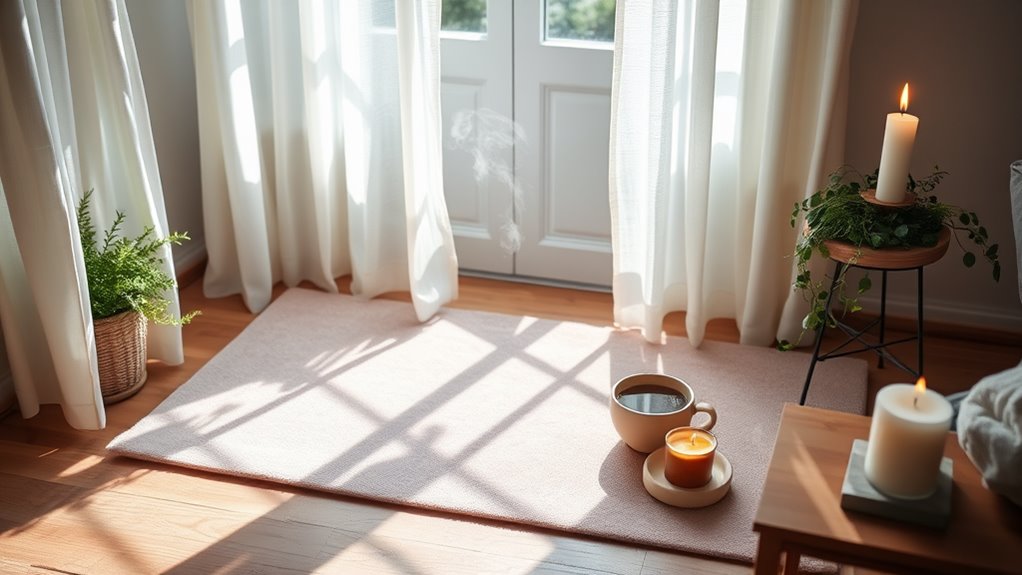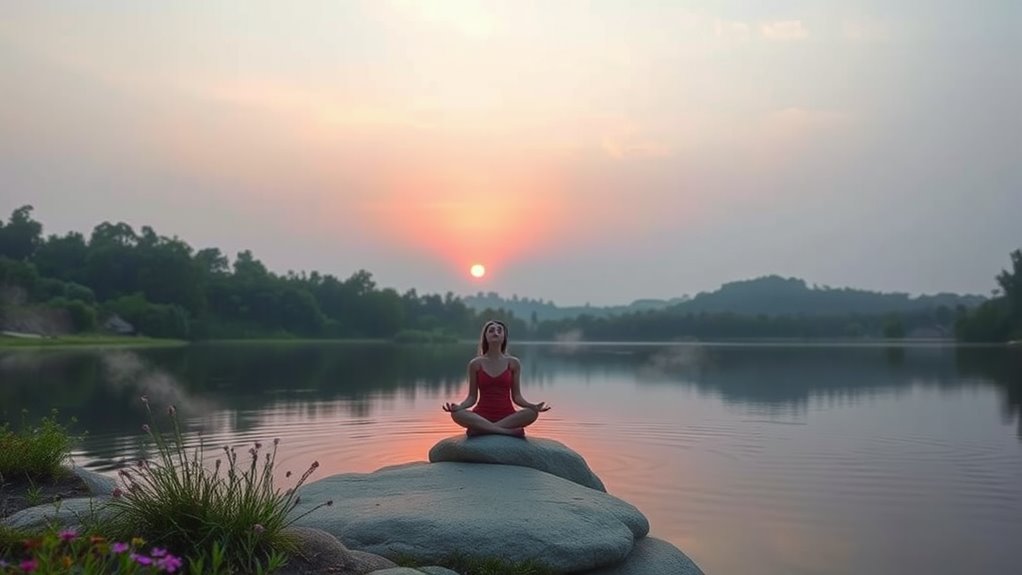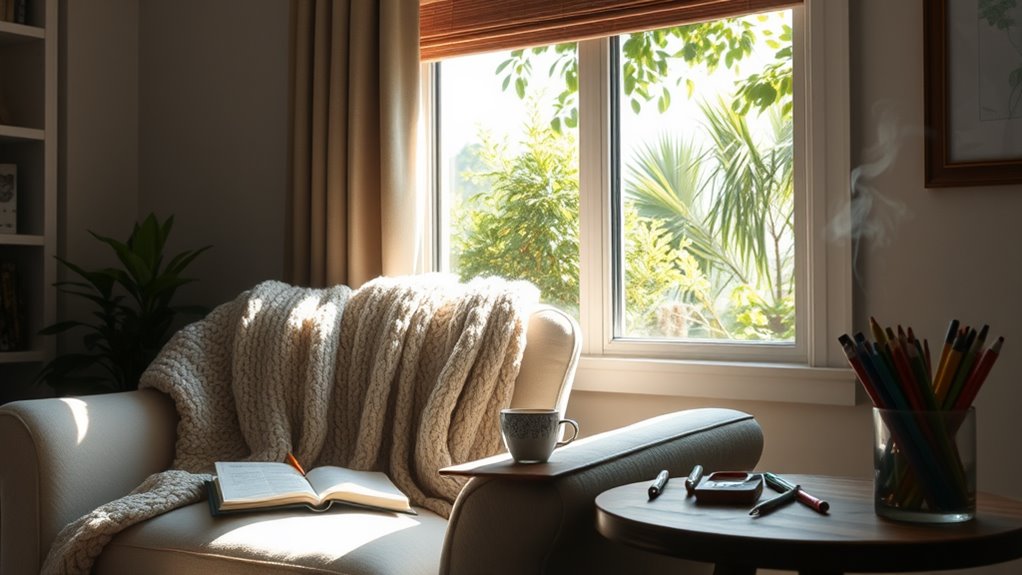Relaxation Techniques You’ll Want to Use Every Day
You can transform your daily life by incorporating effective relaxation techniques that easily fit into your routine. Start with deep breathing exercises to regain calm and focus. Try Progressive Muscle Relaxation by systematically tightening and relaxing muscle groups. Mindful meditation only takes five minutes and helps center your thoughts. Gentle stretching routines can release tension and improve flexibility. Finally, use visualization techniques to picture serene settings, engaging all your senses. These practices are simple yet powerful ways to manage stress. There’s plenty more useful information waiting for you to discover.
Key Takeaways
- Practice deep breathing exercises daily to regain calm and lower stress levels effectively.
- Incorporate progressive muscle relaxation to systematically release tension throughout your body.
- Use mindful meditation for just five minutes to enhance focus and promote a sense of peace.
- Engage in gentle stretching routines to improve flexibility and relieve physical tension.
- Implement visualization techniques to mentally escape stress and reinforce positive outcomes in your life.
Deep Breathing Exercises
When you feel overwhelmed or stressed, deep breathing exercises can help you regain a sense of calm and focus.
Start by finding a quiet space where you can sit or lie down comfortably. Close your eyes, and take a deep breath in through your nose, allowing your abdomen to expand. Hold that breath for a moment, then slowly exhale through your mouth.
Repeat this process for five to ten minutes, concentrating on the rhythm of your breath. As you inhale, visualize positive energy filling your body, and as you exhale, imagine releasing tension and negativity.
This simple technique not only calms your mind but also lowers your heart rate, bringing you back to a relaxed state ready to face whatever comes next.
Progressive Muscle Relaxation
After you’ve practiced deep breathing to calm your mind, you can enhance your relaxation routine with Progressive Muscle Relaxation (PMR).
This technique helps you release tension by systematically tightening and relaxing different muscle groups. Here’s how to do it:
-
Start with your feet: Curl your toes tightly for five seconds, then relax. Feel the difference in tension and ease.
-
Move to your arms: Clench your fists and squeeze your biceps for five seconds, then let go. Notice how your muscles soften.
-
Finish with your face: Scrunch your facial muscles tightly, hold for five seconds, and then release. Enjoy the sense of calm spreading across your face.
Mindful Meditation Practices
How can you incorporate mindfulness into your daily routine? Mindful meditation can be a powerful tool for enhancing your overall well-being. Start by setting aside just five minutes each day to focus on your breath. You’ll quickly notice how grounding this practice can be. Explore different styles, like guided meditation or body scans, to find what resonates with you.
| Time of Day | Mindful Activity |
|---|---|
| Morning | Set intentions for the day |
| Afternoon | Take a mindful break |
| Evening | Reflect on your day |
Gentle Stretching Routines
Incorporating gentle stretching routines into your day can greatly enhance your relaxation and flexibility.
These simple movements can release tension and refresh your mind.
Try these stretches to feel more at ease:
-
Neck Rolls: Slowly roll your head in circles, releasing tightness in your neck and shoulders.
-
Seated Forward Bend: Sit with your legs extended, reach forward, and gently fold over your legs to stretch your spine and hamstrings.
-
Cat-Cow Stretch: On all fours, alternate between arching your back (cat) and dipping it (cow) to relieve back tension and improve mobility.
Visualization Techniques
Gentle stretching routines not only help release physical tension but can also set the stage for more profound relaxation through visualization techniques.
Once you’re relaxed, close your eyes and picture a serene setting—maybe a beach, forest, or mountain. Engage your senses: hear the waves, smell the pine trees, feel the cool breeze.
As you immerse yourself in this mental image, let go of any stress. Visualizing peaceful scenes can shift your mindset and promote a sense of calm. You can even visualize achieving your goals, reinforcing positive outcomes.
Practice this daily, and you’ll find it easier to tap into relaxation whenever you need it. Remember, the mind is a powerful tool; use it to create your oasis of tranquility.
Frequently Asked Questions
How Long Should I Practice Relaxation Techniques Each Day?
You should practice relaxation techniques for at least 10 to 20 minutes each day. It helps you feel more centered and reduces stress. Start small and gradually increase the time as you get comfortable.
Can Children Benefit From These Relaxation Techniques?
Absolutely, children can benefit from relaxation techniques! They help reduce stress, improve focus, and enhance emotional well-being. By incorporating these practices, you’ll empower your child to manage their emotions and navigate challenges more effectively.
What Time of Day Is Best for Relaxation Practices?
The best time for relaxation practices depends on your schedule. Many find early mornings or evenings effective, as these moments allow you to unwind and reflect, setting a positive tone for the day or promoting restful sleep.
Are There Any Relaxation Techniques Suitable for Beginners?
You can start with deep breathing, gentle stretching, or guided meditation. These techniques are simple and effective, helping you ease tension and cultivate a sense of calm. Just remember to practice regularly for best results.
How Can I Create a Calming Environment for Relaxation?
To create a calming environment, dim the lights, play soft music, and declutter your space. Incorporate soothing scents like lavender or eucalyptus, and arrange comfortable seating to help you unwind and feel at ease.





